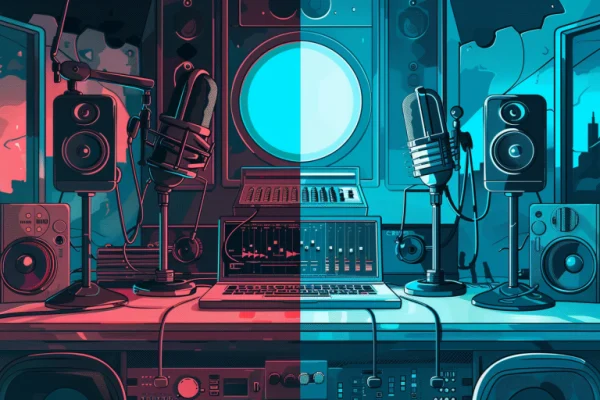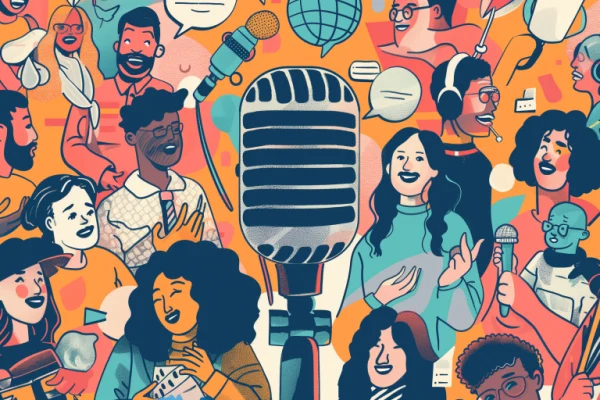The world of podcasting has experienced exponential growth in recent years, becoming a powerful tool for content creation and idea monetization. monetización de ideas.
As a result, having a clear understanding of what is needed to make a podcast is essential before starting to create our content.
More and more creators are venturing into the world of podcasting, taking advantage of its popularity and the ability to connect with passionate audiences.
Moreover, currently, this format has become one of the most accessible and versatile ways to share information, entertainment, and knowledge on any topic.
But, what do you need to make a podcast and monetize it?
In this article, we will explore the fundamental steps to start our own podcast and turn it into a regular source of income.
First and foremost, it is important to understand what a podcast is and how it works.
What is a podcast and how does it work?
Quick answer (the one I used to give my grandma): A podcast is like the radio, but you listen to it on the internet.
For a more elaborate answer, we should specify that listeners can subscribe to programs of their interest and receive notifications about newly published episodes automatically on their devices.
Unlike traditional radio, podcasts offer greater flexibility and availability as they can be listened to at any time and place.
The beauty of podcasting lies in its simplicity.
To get started, we need an idea or topic that we are passionate about and have experience, knowledge, or curiosity about.
Then, with the right equipment and tools, we can record and edit our content to create engaging and high-quality episodes.
However, the monetization process is equally crucial.
It's not just about sharing our ideas, but also about turning our passion into a sustainable source of income.
Through smart strategies, we will be able to monetize our podcasts and generate profits from this content.
In the following points, we will delve into the essential elements to create a successful podcast in detail..
We will discuss the necessary equipment and software, recording and editing techniques, as well as platforms and strategies for publishing and promoting our podcast.
In summary, podcasting represents a unique opportunity for content creators. It is a form of personal expression, a means to share knowledge, and at the same time, a way to monetize your skills.
Do you want to know what it takes to create a podcast and make money from it?
Let's go for it!

How does a podcast work?
This is what it takes to make a podcast since its operation involves several key steps.
- Planning and content creationWe choose a specific topic or niche that we specialize in or are passionate about, and plan the episodes. This involves researching, creating scripts, and establishing the structure of the content.
- Recording the episode:Once we have planned it, we proceed to record it. Creators use recording equipment such as high-quality microphones, headphones, and mixers to capture the audio. It is important to choose an appropriate environment to minimize external noise and ensure good sound quality.
- Editing and post-production: After recording, we need to edit the audio to improve quality, remove mistakes, and add additional elements such as background music or sound effects.
- Storage and distribution: Una vez que el episodio está editado, Lo guardamos en un formato de archivo compatible, como MP3. Luego, lo subimos a una plataforma de alojamiento de podcasts, que actúe como un repositorio en el que se almacena el archivo de audio. Desde allí, se distribuye a través de plataformas populares como Apple Podcasts, Spotify, Google Podcasts, entre otras, para que los oyentes puedan acceder a él.
- Audience interaction: Listeners can subscribe to the podcast and automatically receive new episodes. They also have the option to leave comments, reviews, and engage in social media related to the podcast. This interaction is key to building a community of loyal followers.
What do you need to make a podcast and monetize it?
Podcasting is an accessible and versatile form of content creation, but to do it effectively, you need to have specific elements and tools.

Here are some of the most important elements:
Necessary hardware
- Quality microphone: A good microphone is essential to achieve professional audio quality. USB microphones like the Shure MV7 or the Samson Q2U (which we use) because the Blue Yeti is a piece of sh*t, are great options. If you want even better quality, condenser microphones with an audio interface can provide better results.
- Headphones: Using headphones while recording allows you to monitor audio quality and detect any issues during recording.
- Audio mixer (optional): An audio mixer allows you to adjust sound levels and control multiple audio devices simultaneously. If you plan to have guests on your podcast or use multiple sound sources, a mixer can be helpful.
- Computer or mobile device: You will need a computer or a mobile device to perform tasks such as recording, editing, and publishing your episodes. Make sure that your device meets the minimum requirements for the audio editing programs you choose to use.
- Internet connection: If you plan to record virtually with others, a good internet connection is necessary. Whenever possible, connect to the internet through a wired connection to maximize bandwidth.
Necessary software
- Recording and audio editing software: There are several software options for recording and editing your podcast audio. Some popular options include Audacity (free and open-source), Adobe Audition (paid), and GarageBand (available for free to Mac users).
- Podcast hosting platforms: You will need a podcast hosting platform to store your audio files and generate an RSS feed that distributes your podcast. Popular platforms include Anchor (now Spotify for Podcasters), iVoox, Spreaker, or Acast.
Other important requirements
- Suitable recording space: It is advisable to consider recording your episodes in a quiet place with good acoustics. Reduce background noise as much as possible and consider using acoustic insulation, such as soundproof panels if necessary (or feasible).
- Episode scripts or outlines: Prepare scripts or outlines for your episodes. This will help you organize your ideas and maintain a coherent flow of conversation.
- Music and sound effectsAdding intro music, outro music, or transitions, as well as sound effects, enhances the listening experience of your podcast. You can find free music and sound effects or acquire licenses to use them legally.
The quality of content and delivery is crucial to attract and retain your audience.
The more time and effort you dedicate to these aspects, the better chance you have to achieve your goals.
How to record your voice for the podcast?
The quality is a crucial aspect for the success of your podcast.
Here's what you need to make your podcast sound clear and professional.
Preparation before recording
- Select a suitable environment: Find a quiet and noise-free place to record your episodes, avoiding rooms with excessive echo or background noise such as appliances, traffic, or people talking. If necessary or feasible, you can use soundproof panels or record in a closet full of clothes to reduce echo and external noises.
- Eliminate potential sources of noise: Make sure to turn off or move away from any devices that may generate unwanted noise, such as mobile phones, fans, clocks, etc. Your recording environment should be free from interruptions.
- Prepare your recording space: If you experience echo or reverberation issues in the room, you can use pillows, blankets, or acoustic panels to improve sound quality. Be mindful of plosive sounds like "B" or "P" as their pronunciation can be troublesome. You can use a pop filter or as Pol Rodríguez says, or adjust the microphone position to avoid them.

Equipment and microphone setup
- Connect the microphone: Connect the microphone to the appropriate port on your computer or audio interface. If you're using a USB microphone, simply connect it to the USB port of your computer.
- Adjust the microphone position: Position the microphone at an appropriate distance from your mouth (typically around 15-30 centimeters). It's important not to have the microphone too close, as it can cause distortion or excessive breath noises.
- Perform sound checks and recording levels: Before starting the recording, let's test the sound to verify that the microphone is capturing our voice correctly. The better the original recording sounds, the less work we'll have to do in the editing process.
Recording and voice techniques
- Read aloud and naturally: When recording, read your script or speak naturally and fluently, avoiding sounding too formal or monotonous. A suitable pace and a good tone of voice will keep your listeners engaged.
- Use strategic pauses and silences: Pauses and silences are essential for rhythm and clarity in your speech. Use them to emphasize key points, allow listeners to absorb information, or facilitate editing later on.
- Control your breathing: One of the more challenging aspects is learning to breathe properly while speaking to avoid losing your voice tone during the recording. I can assure you that speaking with a friend is not the same as recording in front of a microphone.
How to edit your podcast audio?
Audio editing is a crucial stage for improving the quality and flow of your content.
Here is a step-by-step guide on what it takes to make a podcast correctly.
Select an audio editing software
- Choose an audio editing program: Any audio editing software will work for this purpose. One of the most commonly used is Audacity (free and open-source), but you can also use Adobe Audition (paid) or GarageBand (available for free to Mac users).
These three tools offer a wide range of features and are popular among podcast creators.
Basic editing steps
- Import the audio file: If you didn't record directly in the editing software, you need to import the recorded audio file.
- Trim silences and mistakes: Identify unnecessary silences, pronunciation errors, fillers, or unwanted sections and trim them to improve the flow of the episode. Ensure a smooth transition between edited sections.
In this aspect, each creator has their own editing style, and each knows what it takes to make a podcast to their liking.
- Adjust sound levels: Use equalization and normalization tools to adjust sound levels. Also, balance the volume of your voice to ensure there are no excessively high or low audio peaks. This will provide a pleasant and consistent listening experience.
- Add music and sound effects: If you want to add background music, sound effects, or transitions, import those audio files and place them in the appropriate places in your episode, making sure the volume of these elements doesn't overpower your main voice.
- Mix and adjust audio: Mixing tools allow you to balance the sound levels of different audio tracks. Ensure that all voices and audio elements are clear and balanced with each other.
- Apply audio effects and enhancementsYou can add special effects or improve audio quality by exploring the effects functions in your editing software. Also, use equalizers, compressors, noise reduction, or other tools to enhance clarity and overall sound quality.
- Listen and make adjustments: After making the main edits, it's recommended to listen to the complete episode to ensure everything sounds good. If necessary, make additional adjustments, trim additional sections, or make last-minute corrections.
IMPORTANT: Let's not over-edit beyond our capabilities. Instead, let's find our basic standard of sound rather than spending hours trying to perfect the sound out of fear that the podcast won't sound as good as we'd like.
A secret that nobody will tell you is that no podcaster is ever fully satisfied with the final result of their podcast.
It's enough to achieve the basic editing that is needed to make a podcast and make it sound decent. At least for a start, that will be sufficient.
- Export the final file: Once we are satisfied with the editing, we need to export the audio file as an MP3 format to upload it to the internet. Some platforms accept other file formats, but MP3 is the most common.
How to upload your podcast audio to the internet?
After editing and finalizing our episode, it's time to upload it to the internet and share it with our audience.
What do you need to make a podcast and upload it to the internet? The following:
- Researching hosting platforms: There are several options for storing and distributing our audio content. . Some options include Anchor (Spotify for Podcasters), Spreaker, Acast, iVoox, and, of course, Mumbler. We should research and choose the platform that best suits our needs in terms of storage, statistics, integrations, and ease of use.
- Create an account on the selected platform: Register on the chosen hosting platform and create an account. Fill in the required information and set up the details of our podcast such as the title, description, category, and cover image..
Upload your audio and generate an RSS feed
- Prepare the audio file: Our audio file should be in a compatible format, such as MP3, and tagged with episode information such as title, description, and author details.
- Upload your audio to the hosting platform: On the selected hosting platform, look for the option to upload your audio file. This is usually quite intuitive, and it's just a matter of following the instructions provided by each platform.
- Complete episode details: On the platform, fill in the episode details such as title, description, and relevant tags. It's very important to use keywords related to the content of our episode and optimize the description to improve visibility in search engines.
- Generate the RSS feed: Once our audio is uploaded, the hosting platform will automatically generate an RSS feed for our podcast. This feed is necessary for distributing the content to various listening platforms.
Another very important thing you need to make a podcast successful is to ensure that it is distributed properly and conveniently.
Distribute your podcast on platforms and directories
- Submit your RSS feed to listening platforms : Using the RSS feed generated by the hosting platform, we can submit our podcast to popular podcast platforms and directories. Some important platforms include Apple Podcasts, Spotify, Google Podcasts, and iVoox. Each platform has its requirements and specific guidelines to follow for proper submission.
- Promote your podcast on your website and social media: It's essential to create a dedicated page for your podcast on your website and link it to the RSS feed. Promote the podcast on your social media channels and encourage your followers to subscribe and share it. In some cases, it may be advisable to create specific social media accounts for each podcast and use marketing strategies to gain more visibility.

Where to host your podcast audio file?
When hosting your podcast audio file, it's important to choose a reliable and scalable platform that provides efficient storage and distribution.
Here's what you need to make a podcast and host it according to your convenience and that of your listeners.
Podcast hosting platforms
- Anchor (now Spotify for Podcasters): It is a free and user-friendly podcast hosting platform. It offers unlimited storage, distribution to popular platforms, and basic editing tools, all in one place. Anchor also facilitates monetization and collaboration with other podcasters.
- iVoox: It is one of the most popular platforms among podcasters in Spain, perhaps because it was one of the first. While it works very well, the public feed only allows playback of the latest 20 episodes outside their platform unless you have one of their paid plans.
- Spreaker: Another widely chosen platform that offers many options to facilitate content distribution and monetization. It made some changes a few months ago that considerably improve the user experience.
- Mumbler: We wouldn't be honest with ourselves or with you if we didn't mention our own platform. At Mumbler, we provide various options for hosting, broadcasting, and promoting your content, as well as opportunities to monetize it.
We also include email marketing tools to connect with your audience and offer special plans for hosting your podcast and controlling everything that happens around it.
Regardless of the chosen hosting platform, consider the amount of storage offered, the quality of service, ease of use, distribution options, and analytics tools provided.
It's also important to review the terms of service and policies of each platform to ensure they meet your needs and objectives for your podcast.
Why host your podcast on Mumbler?
At Mumbler, your audience belongs to you and no one else.
Unlike other platforms, you have complete control over the people who subscribe to your podcast, allowing you to build a real database that you can contact at any time.
Launches, email marketing campaigns, and having your own creator page are some of the extra benefits you can find on our platform.
At Mumbler, you have everything you need to make a podcast and start earning money.
Publishing and promoting your podcast
Once our podcast is created and hosted, it's time to share it with the world and promote it to reach our target audience.
What do you need to make a podcast and promote it effectively?
Set a schedule and be consistent
- Establish a publishing frequency: Decide how often you will release new episodes. It can be weekly, bi-weekly, or monthly, depending on your capacity and resources. Whatever frequency you choose, it's important to be consistent so that your audience knows when to expect new episodes.
- Maintain consistency in duration and format: Make an effort to keep a similar duration for each episode and use a consistent format throughout. This helps set expectations for your audience and allows them to become familiar with the structure of your episodes.
Promote your podcast on your website and social media
- Create a dedicated page on your website: Include a podcast description, a list of previous episodes, and links to listen and subscribe. It's also important to optimize the page with relevant keywords to improve visibility in search engines.
- Share your podcast on social media: Create engaging social media posts highlighting your latest episodes to attract new listeners. Include interesting snippets or standout quotes. Harness the power of social media to reach a wider audience and encourage your followers to share and subscribe.
In this aspect, it's crucial to establish a strategy that allows you to be consistent. Don't abandon your podcast once it's published.
We've put in too much effort so far to leave it in the hands of damn algorithms.
Collaborate with other creators and platforms
- Seek guests and collaborations: If you have the opportunity to invite experts or relevant personalities to your podcast, go for it. This not only brings variety and additional knowledge but also provides access to your guests' audience, which can help increase the visibility of your podcast.
- Participate in interviews and related podcasts: Look for opportunities to be interviewed on other podcasts or engage in collaborations with like-minded creators. This allows you to reach new audiences and establish connections with other creators in the same niche.
Harness the power of email
- Build an email list: Invite your listeners to join an email list by creating a subscription form on your website or through promotions in your episodes. The goal is to keep your subscribers updated on new episodes, news, and podcast-related events.
- Send newsletters: Utilize your newsletter sending tool to send regular emails to your list, including exclusive content, episode previews, direct links to listen and share the latest episodes, and additional material that complements what you discuss on the podcast.
Request reviews and feedback
- Encourage listeners to leave reviews: No tengamos reparos a la hora de pedirle a nuestros oyentes que dejen reseñas y comentarios positivos en plataformas como Apple Podcasts. Reviews influence the decision of other listeners to give a podcast a try and improve visibility in search results.
- Engage with your audience: Take the extra step to respond to comments and questions from your listeners. Encourage participation and interaction by creating an online community around your podcast. This helps build strong relationships with your followers and fosters loyalty towards your content.
Remember that promoting your podcast is an ongoing process.
Explore different marketing strategies and adjust your approaches based on feedback and results. Monitor listening metrics and gather feedback from your audience to continuously improve the quality of your content and tailor it to their needs.
Conclusion
In summary, podcasting has emerged as a popular way to create content and reach audiences in the digital era.
In this article, we have explored everything it takes to start a podcast and monetize our creations.
Now we know what a podcast is and how it works, highlighting its ability to convey information, entertain, and establish connections with our audience.
We have also examined the necessary requirements for podcasting, both in terms of hardware and software, mentioning the importance of recording our voice with professional quality and how to edit the audio to enhance the listening experience.
Furthermore, we have explored how to upload our podcast to the internet and where to host the audio file, highlighting some popular hosting platforms.
Por último, nos sumergimos en la importancia de la promoción y difusión de nuestro podcast, incluyendo la configuración de una programación consistente, la promoción en el sitio web y redes sociales, la colaboración con otros creadores y plataformas, el uso del correo electrónico y la solicitud de reseñas y comentarios.
By leveraging these strategies and tools, we can maximize the visibility of our podcast, reach a wider audience, and effectively monetize our content.
Whether we are in Spain, Latin America, or any other Spanish-speaking region, podcasting offers a versatile and accessible platform to share our knowledge, tell stories, and generate income.
Remember, the key to success in podcasting lies in the passion for the chosen topic, consistency in releasing episodes, and dedication to creating valuable content.
Now that you know what it takes to start a podcast, don't be afraid to express yourself, experiment, and evolve in your content creation journey.
It's your turn.
Have you thought about it? What topic would you like to start creating content about?
About the author
Content Manager at Mumbler.
Podcaster and content creator.
Passionate about communication and a fan of the WordPress community.
I talk about movies and series on Babel Infinito.
I talk about podcasting on Todo por Un Podcast.








